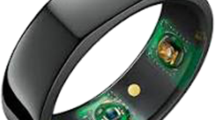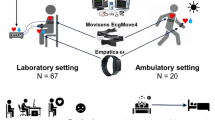Abstract
Most of the wrist-worn devices on the market provide a continuous heart rate measurement function using photoplethysmography, but have not yet provided a function to measure the continuous heart rate variability (HRV) using beat-to-beat pulse interval. The reason for such is the difficulty of measuring a continuous pulse interval during movement using a wearable device because of the nature of photoplethysmography, which is susceptible to motion noise. This study investigated the effect of missing heart beat interval data on the HRV analysis in cases where pulse interval cannot be measured because of movement noise. First, we performed simulations by randomly removing data from the RR interval of the electrocardiogram measured from 39 subjects and observed the changes of the relative and normalized errors for the HRV parameters according to the total length of the missing heart beat interval data. Second, we measured the pulse interval from 20 subjects using a wrist-worn device for 24 h and observed the error value for the missing pulse interval data caused by the movement during actual daily life. The experimental results showed that mean NN and RMSSD were the most robust for the missing heart beat interval data among all the parameters in the time and frequency domains. Most of the pulse interval data could not be obtained during daily life. In other words, the sample number was too small for spectral analysis because of the long missing duration. Therefore, the frequency domain parameters often could not be calculated, except for the sleep state with little motion. The errors of the HRV parameters were proportional to the missing data duration in the presence of missing heart beat interval data. Based on the results of this study, the maximum missing duration for acceptable errors for each parameter is recommended for use when the HRV analysis is performed on a wrist-worn device.






Similar content being viewed by others
References
Iqbal, M.H., Aydin, A., Brunckhorst, O., Dasgupta, P., and Ahmed, K., A review of wearable technology in medicine. J. R. Soc. Med. 109:372–380, 2016.
Reeder, B., and David, A., Health at hand: A systematic review of smart watch uses for health and wellness. J. Biomed. Inform. 63:269–276, 2016.
Nelson, E.C., Verhagen, T., and Noordzij, M.L., Health empowerment through activity trackers: An empirical smart wristband study. Comput. Human Behav. 62:364–374, 2016.
Crawford, K., Lingel, J., and Karppi, T., Our metrics, ourselves: A hundred years of self-tracking from the weight scale to the wrist wearable device. Euro. J. Cult. Stud. 18:479–496, 2015.
Allen, J., Photoplethysmography and its application in clinical physiological measurement. Physiol. Meas. 28:R1–39, 2007.
Tamura, T., Maeda, Y., Sekine, M., and Yoshida, M., Wearable photoplethymographic sensors – Past and present. Electronics. 3:282–302, 2014.
Lee, B., Han, J., Baek, H.J., Shin, J.H., Park, K.S., and Yi, W.J., Improved elimination of motion artifacts from a photoplethysmographic signal using a Kalman smoother with simultaneous accelerometry. Physiol. Meas. 31:1585–1603, 2010.
Mashhadi, M.B., Asadi, E., Eskandari, M., Kiani, S., and Marvasti, F., Heart rate tracking using wrist-type photoplethysmographic (PPG) signals during physical exercise with simultaneous accelerometry. IEEE Signal Process. Lett. 23:227–231, 2016.
Ye, Y., Cheng, Y., He, W., Hou, M., and Zhang, Z., Combining nonlinear adaptive filtering and signal decomposition for motion artifact removal in wearable photoplethysmography. IEEE Sens. J. 16:7133–7141, 2016.
Task Force of the European Society of Cardiology and the North American Society of Pacing and Electrophysiology, Heart rate variability: Standards of measurement, physiological interpretation, and clinical use. Eur. Heart J. 17:354–381, 1996.
Kemp, A.H., and Quintana, D.S., The relationship between mental and physical health: Insights from the study of heart rate variability. Int. J. Psychophysiol. 89:288–296, 2013.
Jost, K., Datta, A.N., Frey, U., Suki, B., and Schulzke, S.M., Heart rate variability predicts duration of respiratory support in preterm infants. Eur. Respir. J. 48:PA1291, 2016.
McCraty, R., and Shaffer, F., Heart rate variability: New perspectives on physiological mechanisms, assessment of self-regulatory capacity, and health risk. Glob. Adv. Health Med. 4:46–61, 2015.
Choi, B.H., Chung, G.S., Lee, J.-S., Jeong, D.-U., and Park, K.S., Slow-wave sleep estimation on a load-cell-installed bed: A non-constrained method. Physiol. Meas. 30:1163–1170, 2009.
Baek, H.J., Lee, H.B., Kim, J.S., Choi, J.M., Kim, K.K., and Park, K.S., Nonintrusive biological signal monitoring in a car to evaluate a driver’s stress and health state. Telemed. J. E. Health. 15:182–189, 2009.
Patel, M., La, S.K.L., Kavanagh, D., and Rossiter, P., Applying neural network analysis on heart rate variability data to assess driver fatigue. Expert Syst. Appl. 38:7235–7242, 2011.
Kim, K.K., Lim, Y.G., Kim, J.S., and Park, K.S., Effect of missing RR-interval data on heart rate variability analysis in the time domain. Physiol. Meas. 28:1485–1494, 2007.
Kim, K.K., Kim, J.S., Lim, Y.G., and Park, K.S., The effect of missing RR-interval data on heart rate variability analysis in the frequency domain. Physiol. Meas. 30:1039–1050, 2009.
Hemon, M.C., and Philips, J.P., Comparison of foot finding methods for deriving instantaneous pulse rates from photoplethysmographic signals. J. Clin. Monit. Comput. 30:157–168, 2016.
Quintana, D.S., Heathers, J.A., and Kemp, A.H., On the validity of using the polar Rs800 heart rate monitor for hert rate variability research. Eur. J. Appl. Physiol. 112:4179–4180, 2012.
Giles, D., Draper, N., and Neil, W., Validity of the polar V800 heart rate monitor to measure RR intervals at rest. Eur. J. Appl. Physiol. 116:563–571, 2016.
Baek, H.J., Cho, C.-H., Cho, J., and Woo, J.-M., Reliability of ultra-short-term analysis as a surrogate of standard 5-min analysis of heart rate variability. Telemed. J. E Health. 21:404–414, 2015.
Munteanu, C., Negrea, C., Echim, M., and Mursula, K., Effect of data gap: Comparison of different spectral analysis methods Ann. Geophys. 34:437–449, 2016.
Von Neuman, J., Kent, R.H., Bellinson, H.R., and Hart, B.I., The mean square successive difference. Ann. Math. Stat. 12:153–162, 1941.
Funding
This work was supported by Samsung Electronics, Inc. and the Soonchunhyang University Research Fund.
Author information
Authors and Affiliations
Corresponding author
Ethics declarations
Conflict of Interest
None of the authors has any conflict of interest.
Ethical Approval
All procedures performed in studies involving human participants were in accordance with the ethical standards of the institutional and/or national research committee and with the 1964 Helsinki declaration and its later amendments or comparable ethical standards.
Informed Consent
Informed consent was obtained from all individual participants included in the study.
Additional information
This article is part of the Topical Collection on Mobile & Wireless Health
Rights and permissions
About this article
Cite this article
Baek, H.J., Shin, J. Effect of Missing Inter-Beat Interval Data on Heart Rate Variability Analysis Using Wrist-Worn Wearables. J Med Syst 41, 147 (2017). https://doi.org/10.1007/s10916-017-0796-2
Received:
Accepted:
Published:
DOI: https://doi.org/10.1007/s10916-017-0796-2




